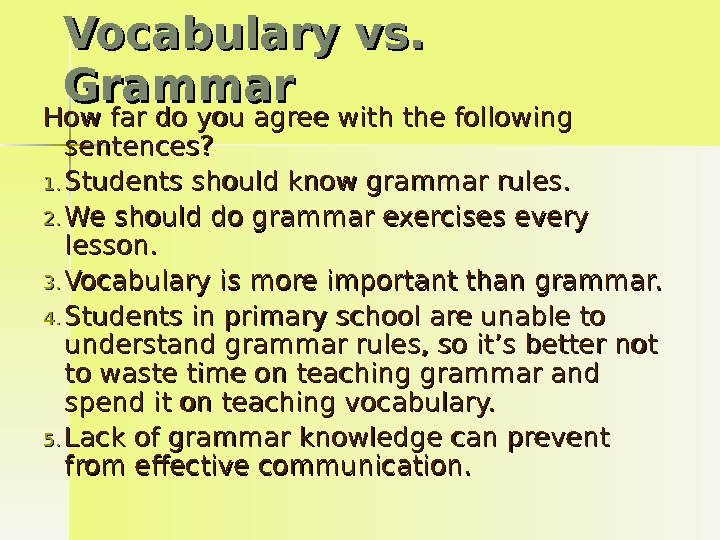Lexis and grammar for primary school Vocabulary



















lexis_and_grammar_for_primary_school.ppt
- Размер: 1.4 Mегабайта
- Количество слайдов: 18
Описание презентации Lexis and grammar for primary school Vocabulary по слайдам
 Lexis and grammar for primary school
Lexis and grammar for primary school
 Vocabulary vs. Grammar How far do you agree with the following sentences? 1. 1. Students should know grammar rules. 2. 2. We should do grammar exercises every lesson. 3. 3. Vocabulary is more important than grammar. 4. 4. Students in primary school are unable to understand grammar rules, so it’s better not to waste time on teaching grammar and spend it on teaching vocabulary. 5. 5. Lack of grammar knowledge can prevent from effective communication.
Vocabulary vs. Grammar How far do you agree with the following sentences? 1. 1. Students should know grammar rules. 2. 2. We should do grammar exercises every lesson. 3. 3. Vocabulary is more important than grammar. 4. 4. Students in primary school are unable to understand grammar rules, so it’s better not to waste time on teaching grammar and spend it on teaching vocabulary. 5. 5. Lack of grammar knowledge can prevent from effective communication.
 Требования ФГОС. Лексика. 500 words for active use (receptive and productive) simple fixed expressions and collocations international words conversational clichés for expressing likes and dislikes word formation (_er, _or, _tion, _ist, _ful, _ly, _teen, _ty, _th ) word formation (compound words) word formation (conversion)
Требования ФГОС. Лексика. 500 words for active use (receptive and productive) simple fixed expressions and collocations international words conversational clichés for expressing likes and dislikes word formation (_er, _or, _tion, _ist, _ful, _ly, _teen, _ty, _th ) word formation (compound words) word formation (conversion)
 Требования ФГОС. Грамматика. main sentence types (questions, imperatives, statements) general and special questions question words (what, who, when, where, why, how) word order in sentences (affirmative and negative sentences) Compound nominative predicate. My family is big. Compound verbal predicate. I like to dance. She can swim.
Требования ФГОС. Грамматика. main sentence types (questions, imperatives, statements) general and special questions question words (what, who, when, where, why, how) word order in sentences (affirmative and negative sentences) Compound nominative predicate. My family is big. Compound verbal predicate. I like to dance. She can swim.
 Affirmative and negative imperatives (Help me, please. Don’t be late) Impersonal sentences (It’s cold) There’s/there’re Sentences with «and» and «but» Sentences with «because» Regular and irregular verbs in Present, Future, past Simple(Indefinite) Infinitive (to play) «To be» as an auxiliary verb Modal verbs can, may, must, have to I’d like to. . . Singular and plural nouns (including exceptions)
Affirmative and negative imperatives (Help me, please. Don’t be late) Impersonal sentences (It’s cold) There’s/there’re Sentences with «and» and «but» Sentences with «because» Regular and irregular verbs in Present, Future, past Simple(Indefinite) Infinitive (to play) «To be» as an auxiliary verb Modal verbs can, may, must, have to I’d like to. . . Singular and plural nouns (including exceptions)
 a(an)/the/zero article Possessive case Adjectives (comparatives, superlatives) Pronouns (personal, object, possessive, Prepositions (in, on, at, into, from, of, with ) Numerals (cardinal/ordinal) from 0 to 100 Adverbs of time ((yesterday, tomorrow, never, usually, often, sometimes). Much, little, very
a(an)/the/zero article Possessive case Adjectives (comparatives, superlatives) Pronouns (personal, object, possessive, Prepositions (in, on, at, into, from, of, with ) Numerals (cardinal/ordinal) from 0 to 100 Adverbs of time ((yesterday, tomorrow, never, usually, often, sometimes). Much, little, very
 Подходы и методы
Подходы и методы
 Структурный метод Основные этапы: 1. 1. Аудирование речевых образцов с грамматической структурой в той или иной последовательности. 2. 2. Хоровое и индивидуальное проговаривание. 3. 3. Вопросно-ответные упражнения с учителем и в парах. 4. 4. Учебный диалог с несколькими структурами.
Структурный метод Основные этапы: 1. 1. Аудирование речевых образцов с грамматической структурой в той или иной последовательности. 2. 2. Хоровое и индивидуальное проговаривание. 3. 3. Вопросно-ответные упражнения с учителем и в парах. 4. 4. Учебный диалог с несколькими структурами.
 Коммуникативный метод Основные этапы: 1. 1. Предварительное слушание подлежащего усвоению материала в конкретной речевой ситуации. 2. 2. Имитация в речи при наличии речевой задачи. 3. 3. Группировка схожих по смыслу (форме) фраз, одновременная отработка однотипных фраз. 4. 4. Разнообразные обстоятельства автоматизации.
Коммуникативный метод Основные этапы: 1. 1. Предварительное слушание подлежащего усвоению материала в конкретной речевой ситуации. 2. 2. Имитация в речи при наличии речевой задачи. 3. 3. Группировка схожих по смыслу (форме) фраз, одновременная отработка однотипных фраз. 4. 4. Разнообразные обстоятельства автоматизации.
 Дедуктивный метод Основные этапы: 1. 1. Изучается правило, сформулированное с использованием специфических грамматических терминов. 2. 2. Учащиеся находят данную структуру в тексте, анализируют его. 3. 3. Выполнение подстановочных упражнений. 4. 4. Трансформационные упражнения. 5. 5. Переводные упражнения.
Дедуктивный метод Основные этапы: 1. 1. Изучается правило, сформулированное с использованием специфических грамматических терминов. 2. 2. Учащиеся находят данную структуру в тексте, анализируют его. 3. 3. Выполнение подстановочных упражнений. 4. 4. Трансформационные упражнения. 5. 5. Переводные упражнения.
 Индуктивный подход. Основные этапы: 1. 1. Предъявление текста (набора предложений) с достаточно большим кол-вом нового грамматического явления в контексте. 2. 2. Формулирование правила учащимися. 3. 3. Выполнение упражнений на подстановку. 4. 4. Выполнение упражнений на трансформацию. 5. 5. Переводные упражнения.
Индуктивный подход. Основные этапы: 1. 1. Предъявление текста (набора предложений) с достаточно большим кол-вом нового грамматического явления в контексте. 2. 2. Формулирование правила учащимися. 3. 3. Выполнение упражнений на подстановку. 4. 4. Выполнение упражнений на трансформацию. 5. 5. Переводные упражнения.
 Prictising grammar Songs, chants and rhymes
Prictising grammar Songs, chants and rhymes


 Practising grammar (games)
Practising grammar (games)

 Assessing grammar
Assessing grammar
 Stages of learning grammar Noticing Structuring Proceduralising
Stages of learning grammar Noticing Structuring Proceduralising

